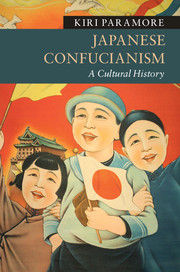Book contents
- Frontmatter
- Epigraph
- Contents
- List of figures
- List of maps
- Acknowledgments
- Notes on the text
- Timeline
- Maps
- Introduction
- 1 Confucianism as cultural capital (mid-first millennium CE–late sixteenth century CE)
- 2 Confucianism as religion (1580s–1720s)
- 3 Confucianism as public sphere (1720s–1868)
- 4 Confucianism as knowledge (1400s–1800s)
- 5 Confucianism as liberalism (1850s–1890s)
- 6 Confucianism as fascism (1868–1945)
- 7 Confucianism as taboo (1945–2015)
- Epilogue: China and Japan: East Asian modernities and Confucian revivals compared
- Notes
- Works Cited
- Index
6 - Confucianism as fascism (1868–1945)
Published online by Cambridge University Press: 05 April 2016
- Frontmatter
- Epigraph
- Contents
- List of figures
- List of maps
- Acknowledgments
- Notes on the text
- Timeline
- Maps
- Introduction
- 1 Confucianism as cultural capital (mid-first millennium CE–late sixteenth century CE)
- 2 Confucianism as religion (1580s–1720s)
- 3 Confucianism as public sphere (1720s–1868)
- 4 Confucianism as knowledge (1400s–1800s)
- 5 Confucianism as liberalism (1850s–1890s)
- 6 Confucianism as fascism (1868–1945)
- 7 Confucianism as taboo (1945–2015)
- Epilogue: China and Japan: East Asian modernities and Confucian revivals compared
- Notes
- Works Cited
- Index
Summary
Considering the achievements of our long national history, the fate of the world some centuries from now may well be to see our nation assimilate and refine even Western culture. I firmly believe this is our nation's great aspiration and indeed its manifest destiny.
– Hatoyama Ichirō, Minister for Education and Culture, 27th January, 1934, at the inauguration of the Association for the Propagation of Japanese Confucianism (Nihon Jukyō Sen'yōkai 1934: 15)The transformation of Confucianism into an ideological tool of totalitarianism ironically began with authoritarian state suppression of Confucianism. The Meiji Restoration of 1868 was followed by a concerted state attack upon Confucianism. That attack began with abolition of former Tokugawa and domainal institutions of Confucian religious practice and education and was followed by the new state comprehensively displacing Confucianism from the field of education. That displacement, however, was accompanied by a more sinister and deliberate suppression of religious activity across the board. For a number of specific reasons which will be discussed later, Confucianism was particularly hard hit by the broad anti-religious policy of the early Meiji state. Confucian institutions and practice almost completely disappeared from Japan by the late 1880s. By the 1890s, however, some elements of elite Japanese society would begin to see the advantages of a partial resurrection of Confucianism. The nature of that resurrection, however, would maintain the suppression of the religious elements of the tradition, recasting Confucianism within the cold frame of Western philosophy. That philosophical bias, in turn, would lay the foundations for the later linking of Confucianism with fascism.
The early Meiji suppression of Confucianism
In many divergent parts of the world, the rise of modern nationalism has been accompanied by a period of suppression of religion, usually followed by a reorganization of the place of religion in the polity along new nation-state-centered lines. The French Revolution and its aftermath is the classic example of this process, but similar processes also occurred in China and Japan. The religion question was particularly central in Chinese and Japanese processes of Westernization and modernization because the Western imperial powers used the trope of religious freedom centrally in their suppression of local sovereignty – the core element of the rosy-sounding “openings” of China and Japan.
- Type
- Chapter
- Information
- Japanese ConfucianismA Cultural History, pp. 141 - 166Publisher: Cambridge University PressPrint publication year: 2016

